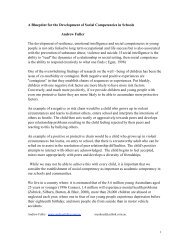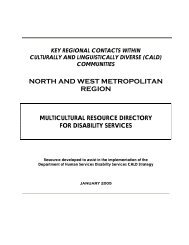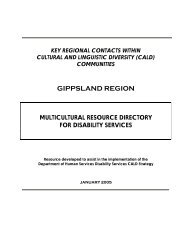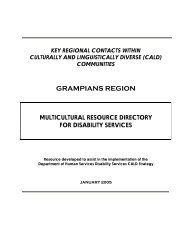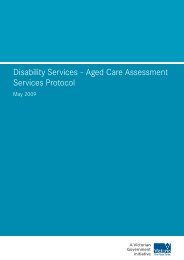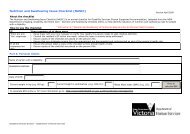Positive Behaviour Support - Department of Human Services - Vic ...
Positive Behaviour Support - Department of Human Services - Vic ...
Positive Behaviour Support - Department of Human Services - Vic ...
You also want an ePaper? Increase the reach of your titles
YUMPU automatically turns print PDFs into web optimized ePapers that Google loves.
PowerPoint 104<br />
PowerPoint 105<br />
*<br />
*<br />
<strong>Positive</strong> behaviour support: Getting it right from the start - Facilitators reference manual 77<br />
2. Independence<br />
Some people will show behaviours <strong>of</strong> concern as a means <strong>of</strong> getting an object, activity or<br />
sensory experience. When this is the case, we can teach the person to independently, but<br />
appropriately get these things.<br />
Simone<br />
Setting<br />
(background factor)<br />
Simone disliked being in<br />
large groups<br />
Trigger<br />
(setting event)<br />
Simone and everyone<br />
else completed breakfast<br />
and personal hygiene<br />
tasks and were waiting in<br />
the lounge room<br />
Function: Simone got to go outside<br />
Message: Let me out, I want to be alone<br />
<strong>Positive</strong> behaviour support strategies<br />
Action<br />
(actual behaviour)<br />
Hitting, bitting and<br />
scratching co residents<br />
Result<br />
(outcome achieved)<br />
Staff sat outside with<br />
Simone on the front<br />
bench until the taxi<br />
arrived<br />
Environmental change All staff are made aware that Simone wants to sit outside and wait for her taxi rather<br />
than waiting inside<br />
Replacement<br />
independence skill<br />
Simone was taught to let herself out the front door using her own key and wait on<br />
the front bench for her taxi<br />
3. Coping skills<br />
Sometimes people show behaviours <strong>of</strong> concern because they are frustrated, disappointed,<br />
angry or scared and this provides them with some relief. It could be that the behaviour helps<br />
the person cope with a bad situation (others may comfort the person, give them something<br />
else to do or speed up their access to something they have been denied). On the other hand<br />
just performing the behaviour may help the person calm down because it allows them to vent<br />
their feelings.<br />
John<br />
Setting<br />
(background factor)<br />
John dislikes strangers in<br />
his environment<br />
Trigger<br />
(setting event)<br />
A new maintenance<br />
man is fixing a broken<br />
doorhandle in John’s<br />
room when John arrives<br />
from work<br />
Action<br />
(actual behaviour)<br />
John takes the<br />
maintenance man’s<br />
toolbox and throws it out<br />
the door<br />
Function: Expression <strong>of</strong> anxiety at having a stranger in the house<br />
Message: I don’t know who you are, ‘go away’<br />
<strong>Positive</strong> behaviour support strategies<br />
Environmental change Staff to let John know when a stranger/or someone new is coming<br />
Staff develop a ‘who’s here today’ board<br />
Replacement<br />
independence skill<br />
Result<br />
(outcome achieved)<br />
The maintenance man<br />
yells at John and tells him<br />
he will pay for everything<br />
that is broken<br />
John was taught:<br />
- to place a picture on the who’s here today board to remind John when someone<br />
new is coming<br />
- to introduce himself to strangers invited into the house and to ask them their<br />
name and purpose <strong>of</strong> being there.



